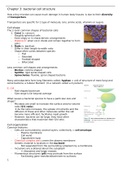Summary
Summary Chapter 3 - Bacterial cell structure. Prescott's Microbiology
- Course
- Institution
- Book
Here is a summary of chapter 3 bacterial cell structure. The source is Prescott's Microbiology. Created according to the Health & Life 2023 Microbiology learning line. 3.1-3.6 and 3.7, 3.8 and 3.10
[Show more]




